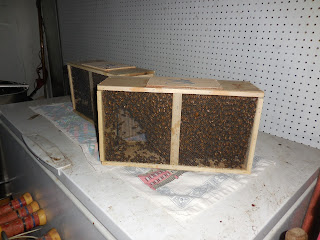Bees getting ready for winter.
All of the males (drones) have now been kicked out of the hives. This usually happens once the temperature dips to about 30-40 F degrees for a few days in a row in the fall.
The hives are now heavily propolized (sealed with propolis, natures own sealant) to keep cold winter winds out of the gaps of the hives. Propolis is made from plant parts and bee saliva and pasted over every gap and crack and crevice. There are over 60lbs of honey now stored in each hive. This is the amount needed to get through an average mid-Atlantic winter. (They replenished that which I took during extraction in June, when I fed them sugar water from August through September.) The bees are now clustering in each hive around their respective queen, once the temperature falls below 45F. We hope they cluster under the honey stores so as they can move up in the hive through the winter where there is always honey readily available for to them to eat. It supplies the energy for them to vibrate and keep the hive warm at around 90F all winter long. The queen remains warmest in the center of the cluster. On warmer winter days (above 58F), they will break cluster and take cleansing flights (as pictured above), coming out of the hives to get rid of metabolites that have built up inside their bodies. Metabolism is much slower in winter bees and at cooler temperatures, so they do not become poisoned by their own metabolites building up; but they do need to take these flights to cleanse themselves, or this might ultimately occur. (Winter bees have a different longevity and metabolism from summer bees, allowing for this to work.)
Follow Dr. Kathy as she enters her 7th through 11th years of beekeeping in rural MD.
Wednesday, November 30, 2016
Friday, April 15, 2016
Dr. Kathy gets her Spring, 2016 bees (a photo montage)
 Beehives (with weedblock in front) are cleaned, setup and ready to receive this year's two bee packages when they come.The call comes from the local bee club.
Beehives (with weedblock in front) are cleaned, setup and ready to receive this year's two bee packages when they come.The call comes from the local bee club.
Past President Bill Bundy is back with the bees from Georgia. He's brought everyone's bees in his horse trailer. Dr. Kathy mixes up her 50-50 sugar syrup with a bit of fumigilin (antibiotic to calm the bees down) and some vinegar (to prevent mold growth) and puts it in a spray bottle.

Dr. Kathy drives straight from work in her company car to Bill's farm to get her bees.
Don't drop those packages!
Once at their new home in Brunswick, MD, the bees are spritzed on the front yard. They are thirsty!
Each package has 3 lbs of bees (about 3,000 workers-all girls) in them. There is also a queen cage with a marked queen and 5-6 attendants in each package. The queen cage has a cork at one end and a sugar plug of candy at the other end. Each package also contains a metal syrup can with small punctures at the bottom for the bees to feed on syrup in transit.
They are all clustered around their individual queens because before Sunday (pickup day is Wednesday) they didn't know each other. They were shaken together in this package. They are confused young bees. They detect their new queen's pheromone (a perfume like odor) and are getting used to this. They want to be close to her. So, the cluster forms around her-she is always in the center. She has come from a different background and is not initially recognized, so the queen cage protects her. The candy plug keeps her in the cage. If she were to walk out too soon, she'd be stung to death! But, as they become more and more familiar with her, and recognize her as their new monarch, she will be accepted. Sadly, the attendants in her cage will not be. The queen cannot feed herself. The attendants feed her. They eat the candy plug at the end of the cage. The idea is that by the time they eat through the candy plug to make a hole for her to walk out of, she will be accepted by her new subjects and not stung.
The two packages won't be installed in their new hives immediately because it is so cold at night-still freezing temperatures, so they are stored in the dark and cool basement on top of the freezer. But, one should not store them too long. They need to be installed about 4-6 days after being shaken together.
Until they are installed, the bees are kept in the cool and dark (like a hive). They must be spritzed periodically for sugar water for those on the outside of the cluster who cannot make it in to the can of sugar syrup. Expect some die off from the transit of the packages. This past week has been pretty chaotic for them.
Wednesday, April 13, 2016
The bees are coming!
The bees are coming, the bees are coming! It's about time!!
I pick up my two bee packages later today! The backyard has not seemed right without the hives since the Varroa mites killed them off in late fall.
Weedblock is down in front of the landing boards and the two hives are re-assembled.
Weedblock is down in front of the landing boards and the two hives are re-assembled.
Now, to get my girls! (6002 of them-well, 3K in each package, plus a queen each....give or take a few 100!)
Can't wait for more buzz!
Subscribe to:
Posts (Atom)



















